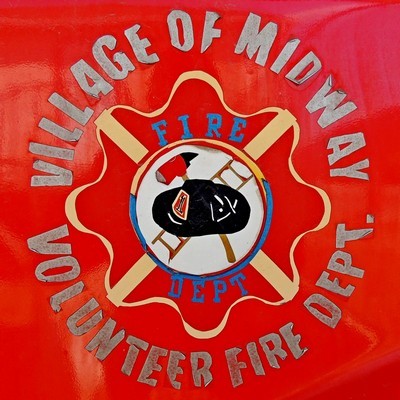
By all accounts the chassis of this small fire truck should be a 1949-1955 Austin Loadstar "Series II" K4, 2 Ton truck. The series was introduced in 1949, remaining in production until the introduction of the "Series III" in 1956. Power came from a 4 litre, overhead valve 6 cylinder gasoline engine which produced 125 horsepower.
Unsurprisingly, many Austin Loadstars saw service as fire trucks, from small "back-of-the-shop" style conversions such as this to larger, full scale, professionally converted pumper engines. This Loadstar has been converted to an all in one pumper-tanker-ladder-hose truck with the addition of a 300 to 400 (or so) gallon water tank, reels and racks for hoses and ladders, a pto driven water pump and a platform at the back on which firemen could ride to a fire.
On each cab door is a hand painted
Village of Midway Volunteer Fire Dept. sign, letting us know that this Loadstar spent at least part of its working life in the service of the people of Midway. Beyond that, little to nothing is known by the writer of the Loadstar's story.
In 1949 the production of a celebrated Austin truck, with smoother lines and a more modern shape was launched. This new model Loadstar or ‘Series II’ was offered in two model derivatives – K2 and K4 – with a load capacity from two to five tons, wheelbase lengths of 2.9m and 4.0m, powered by an inline six-cylinder 3995cc engine, developing 125hp and fitted with a vacuum brake booster.
The 1952 Austin K4 Loadstar was the last Austin truck designed and built by the company, before the economic downturn in the early 1950s forced Austin and Morris to form a joint venture in order to survive, establishing the British Motor Corporation (BMC). The Series II continued as a BMC-built product until 1956, after which the Series III was launched, with a new unified cab and a more aerodynamic sloping bonnet.
The Austin Motor Company was a major manufacturer of cars and trucks and an integral part of the British automotive scene. In 1906, Sir Herbert Austin (1866-1941), who had previously been the CEO of Wolseley cars, established a company bearing his own name in an old printing house at Longbridge village, south of Birmingham.
In April that year, he introduced his first car that was well received and it wasn’t long before Austin offered a range of passenger cars.
The full-scale production of trucks began prior to WWI, when in December 1912 the company released models with a carrying capacity of two and three tons. From February of the following year a five-ton version was produced. However, by October 1917, around 1000 unsold trucks had accumulated in Austin’s storage facilities. Austin cleared much of his unsold stock by 1922, but decided to quit them and concentrate on the production of passenger cars. Paradoxically, he also manufactured a commercial version of almost every passenger car, with payloads ranging from six-hundredweight (300kg) to 1.5-tons.
In January 1939, just before the outbreak of WWII, Austin received a Government order to supply a quantity of truck, so with much enthusiasm he produced a new range. Later named the ‘Series 1’ K2 and K3 models had payloads of two and three tons, respectively. Later 1.5-ton utilities, named K30s, were added to the line-up. The Series 1 was continued after the war until the end of 1948, when the more modern looking post-war Series II entered the marketplace.
From Historic Vehicles
Kettle River Museum
The first railway to arrive in the area was the Columbia & Western, a subsidiary of the CPR. It was an extension of the CPR's line at Castlegar, intended to eventually link to the main line which ran to the coast. This link, known as the Kettle Valley Railway, was finished, finally, in 1915, linking the interior with the coast. The KVR ran from this point 600 km. west to meet the main line at Hope, BC. Built through rugged, mountainous terrain, it was hailed as an engineering landmark when completed.
The line remained in operation until, due to a changing economic climate, the KVR was abandoned and the tracks removed, beginning in 1991. Fortunately for us history buffs, a few far sighted individuals have managed to rescue this station for posterity.
As well as the station, the museum includes a main building housing smaller historical artifacts and interpretive displays of rail, mining, forestry, and agriculture heritage, an artifacts yard with larger artifacts, a caboose, a section house, a 6 bedroom bunkhouse (newly renovated and available to rent for hikers, cyclists and others) and a machine shed, which houses a plethora of mining, railroading and agricultural machinery. In this building is an old Austin Fire Truck, as well. The museum also has a picnic area shaded by a century old maple tree, grown from a seed planted by the wife of the station master.
The Kettle River Museum opened July 12, 1977 in a smaller building within the Village of Midway. That building housed many, or most, of the artifacts and displays to be found in the present main museum building. Some time after 1985 the museum was relocated to this spot to take advantage of the presence of the turn of the century heritage railway station.